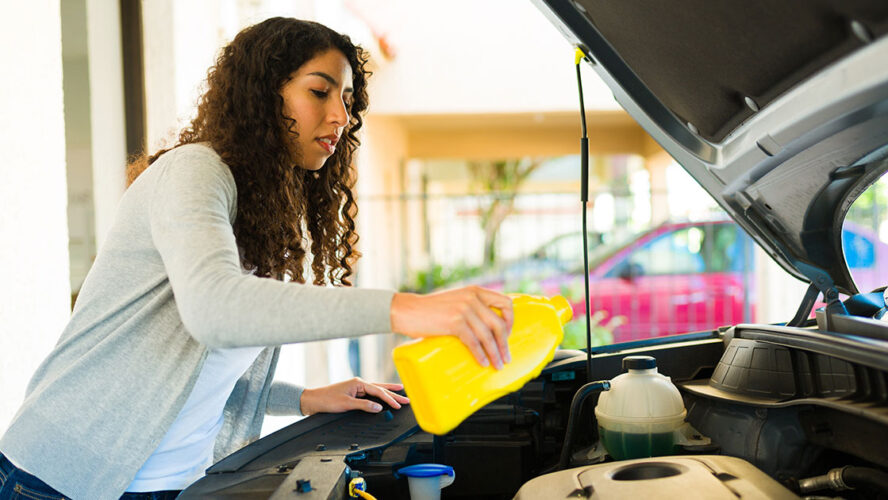Maintaining a vehicle is not just about keeping it looking good; it’s about ensuring it runs safely and efficiently for years to come.

David Bennett
Senior Automotive Manager, AAA
Preventative car maintenance extends your vehicle’s lifespan and ensures it is safe to drive. Yet, many important components in your car require inspection, and all too often, these important tasks slip through the cracks. That’s why here at AAA, we’ve created this comprehensive vehicle maintenance checklist, so you never have to worry about forgetting a necessary maintenance task.
Immediate maintenance tasks
If you find yourself facing any of the following issues, it’s imperative to act quickly:
- Tire Pressure Light: When your dashboard displays a tire pressure light, it indicates that one or more tires have low pressure. Be sure to check and inflate your tires to the recommended levels immediately. Safety comes first.
- Brake System Malfunctions: If you notice a change in your brakes, such as a soft pedal or unusual noises, don’t delay. These symptoms are red flags that could pose a threat to you and others on the road.
- Check Engine Light: Seeing that illuminated check engine light?
- Yellow check engine light (solid) — This indicates a fault within your electronic engine control system. Have the vehicle inspected as soon as possible.
- Yellow check engine light (flashing) — Pull off to the side of the road and turn the engine off immediately. A flashing yellow check engine light indicates a severe engine misfire (typically within the ignition system), which could lead to costly repairs if not immediately addressed.
- Red engine light — Pull off to the side of the road and turn off the engine immediately. This typically indicates an issue with low oil pressure or engine overheating. Have the vehicle towed to a qualified repair facility to diagnose the problem.
- Fluid Leaks Under the Vehicle: Fluid leaks can lead to severe vehicle damage and hazardous situations. If you spot a leak, identify the fluid type and address the source promptly.
Monthly maintenance tasks
Staying proactive can save you time and money. Here are some essential monthly routines:
- Tire Pressure and Wear: Regularly monitor your tire pressure to ensure your tires are properly inflated. Check for uneven tread wear, as well. You can find the recommended tire pressure listed on a sticker located inside the driver’s door. If there’s no sticker on the door, you can also find the information in your owner’s manual. In older cars, the decal may be located in the glove box or inside the fuel filler door. Also, be sure to check your spare tire to ensure it is at the correct level.
- Vehicle Fluids: Regularly inspect your vehicle fluids — engine oil, transmission, power steering, wiper, brake fluid, and coolant. Keep them topped up to maintain optimal vehicle performance.
- Lights Check: Ensure all lights function correctly. A quick external inspection can save you from a traffic ticket and enhance road safety.
- Battery and Cables: Make sure battery connections are secure and free from corrosion to prevent startup issues.
Quarterly maintenance tasks
As the months roll by, don’t neglect these critical checks:
- Wiper Blades: If they smear or streak, replace them. Good visibility during adverse weather is essential.
- Belts and Hoses: Inspect belts for wear and hoses for leaks. Replacing worn components can prevent bigger issues down the line.
Half-yearly maintenance tasks
Every six months, be diligent and perform these tasks:
- Engine Oil and Oil Filter: Keep your engine healthy with regular oil and oil filter changes.
- Tire Rotation: Rotate your tires to promote even wear and extend their lifespan.
- Battery Performance: Especially for older batteries, test their performance regularly.
Yearly maintenance tasks
Annually, take a deep dive into your vehicle’s health:
- Air Filters: A clean cabin filter enhances your driving comfort, while a clean engine filter ensures better engine performance.
- Brakes and Brake Pads: Frequent checks of your braking system ensure a safe driving experience.
- Suspension and Steering: Regular inspections can help catch alignment issues that affect handling, comfort, and uneven tire wear.
Long-term maintenance tasks
Finally, keep an eye on major components that need attention every three to five years:
- Timing Belt: Replace it according to the manufacturer’s recommendation. It’s recommended to replace the water pump at the same time to save you a future expense.
- Battery: Test and replace your battery as needed, particularly to avoid sudden failures. AAA Mobile car battery replacement is a convenient solution.
Remember, keeping your vehicle in peak condition requires commitment and attention. Schedule regular maintenance appointments at a AAA-Approved Auto Repair Facility. Not only can they assist with every aspect of vehicle maintenance, but AAA members also receive a variety of benefits, including discounts and a longer warranty.
Vehicle health is a responsibility we all share. A little effort goes a long way in ensuring a safe journey every time you hit the road. Want to stay on track with your vehicle maintenance tasks throughout the year? Download AAA’s car maintenance checklist to keep you organized and proactive. Your car will thank you for it!

